Banana Kiwi Smoothie Overview
When I’m looking to whip up a quick, healthy drink, a banana kiwi smoothie is my go-to pick. This smoothie is a blend of sweet bananas and fresh kiwi, making a drink that’s both refreshing and packed with nutrients. What I particularly love about this recipe is that it’s vegan and dairy-free, as it avoids traditional yogurt or milk bases.
Ingredients:
- Bananas: They lend a creamy texture and natural sweetness.
- Kiwi: Adds a tangy flavor and a burst of vitamins.
- Liquids (optional): Such as orange juice, almond milk, or just plain water for blending.
As someone who enjoys playing around in the kitchen, I find this smoothie’s simplicity appealing. Usually, I just toss the sliced bananas and kiwi into the blender. If the smoothie is too thick for my liking, I toss in a splash of one of the non-dairy liquids. Here’s a quick snapshot of the process:
- Slice bananas and kiwi.
- Place fruit in the blender, adding a liquid if needed.
- Blend until smooth. Voilà!
Doing without yogurt means this smoothie is lighter and works great for anyone with a dairy intolerance or following a vegan diet. It fits just about any time—whether I’m after a quick breakfast, a midday snack, or a post-workout refresh. As for cuisine, this smoothie doesn’t tie down to any specific type—it’s pretty universal.
One of my favorite things about this combo is how the sweetness of the banana perfectly balances the kiwi’s bold flavor, yielding a drink that’s both indulgent and guilt-free.
Health Benefits

When I whip up a banana kiwi smoothie, I’m not just thinking about the delightful taste; I’m also considering all the health perks that come with it. It’s packed with essential vitamins and minerals, and because it’s dairy-free, it’s perfect for those with dietary restrictions or vegan preferences. Let’s break down the specifics:
Nutritional Content
Bananas are a good source of vitamin C, potassium, and dietary fiber, while kiwis bring even more vitamin C, vitamin A, and fiber to the table. This combo makes for a nutrient-rich drink that contributes to my daily nutritional needs. Plus, kiwis and bananas both contain carbohydrates that offer a quick energy boost.
Dietary Considerations
This smoothie is ideal for those looking to maintain a vegan or dairy-free diet. It’s free from animal products and can easily accommodate a variety of dietary needs. For those concerned about allergies or lactose intolerance, a banana kiwi smoothie without yogurt is a safe and delicious choice.
Weight Management
I find this smoothie to be a smart choice when I’m trying to manage my weight. It’s inherently low in calories but high in fiber and healthy fats if I choose to add ingredients like flaxseeds or chia seeds. These components can increase satiety and reduce my cravings for less nutritious snacks.
Energy and Vitality
Every time I have this smoothie, the combination of natural sugars and carbohydrates provide me with a sustainable release of energy, while the protein (should I opt to add a scoop of protein powder or a handful of nuts) supports muscle repair and growth. lt’s not just a treat; it’s a glass full of vitality.
Smoothie Preparation
When I whip up a banana kiwi smoothie, the two main steps I focus on are picking the right ingredients and blending them to that just-right smooth consistency.
Choosing Ingredients
I always start with fresh fruit. A ripe banana gives the smoothie natural sweetness and a creamy base. For the kiwi, I make sure it’s slightly soft to the touch – this means it’s ripe and flavorful. Sometimes, I throw in a handful of berries, spinach, kale, or other greens for an extra nutrient punch. To keep things cool and thicken the smoothie, I opt for frozen fruit instead of ice, as it doesn’t water down the flavors. If I’m out of frozen bananas, I just toss in a few ice cubes with a splash of water to get the blender going.
Blending for the Perfect Consistency
My blender choice – typically a Vitamix or Ninja – does a fantastic job at crushing frozen fruit and ice, making sure every sip is smooth without chunks. I start at a lower speed to chop the big pieces and then ramp it up to high until the mixture looks even. The trick is to stop and stir once in a while if anything sticks to the sides. For me, the perfect consistency is when the smoothie flows easily but still has some body, almost like a soft-serve ice cream.
Prep time: Usually just takes me 5 minutes or so if I’ve got everything ready to go.
Recipe Variations and Ideas
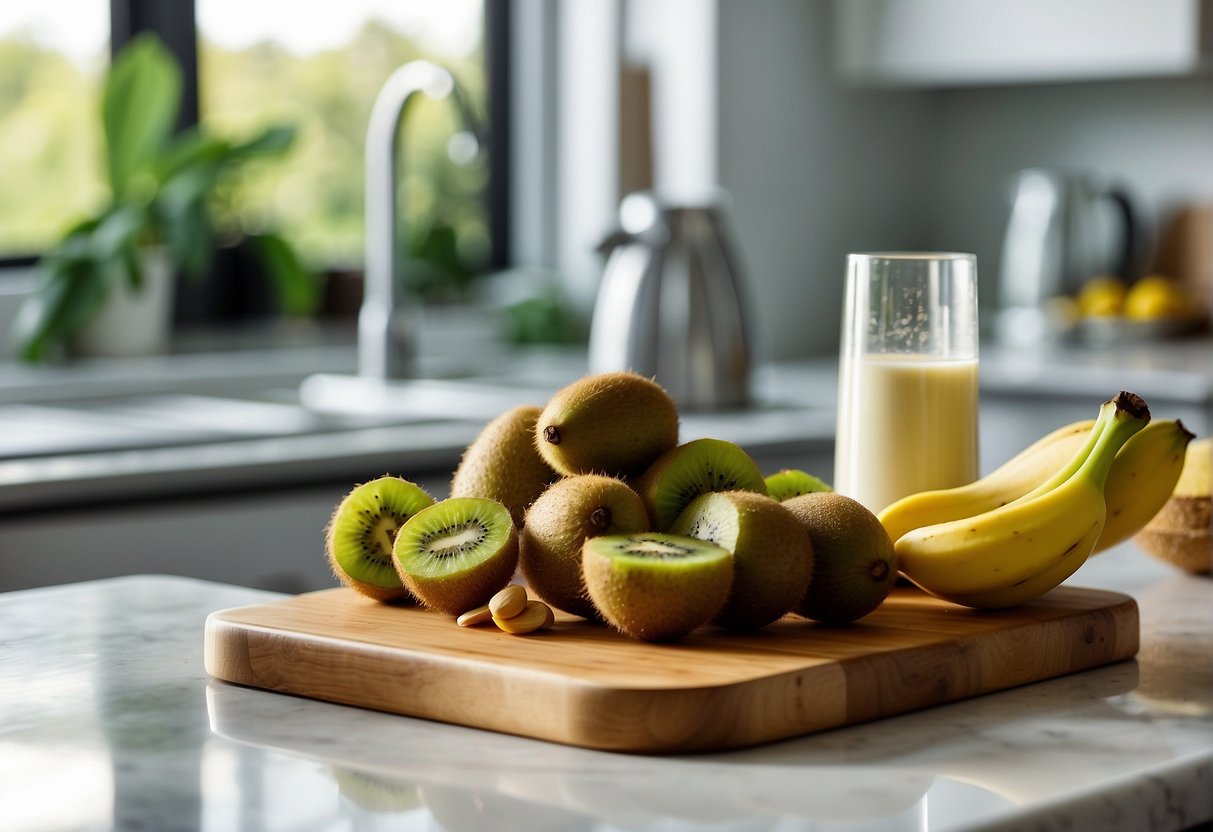
Let’s shake things up a bit. Tailoring a banana kiwi smoothie to your taste buds and nutrition goals is fun and simple. I’ll give you some great ideas whether you’re looking for a sweeter sip, wanting to pump up the protein, or craving a fruity twist.
Sweetness Adjustments
Sometimes a smoothie isn’t sweet enough for my liking, or it’s a bit too much on the sweet side. If I need to amp up the sweetness, I go for natural options like a drizzle of honey or maybe a splash of maple syrup. A ripe banana adds natural sugars, too. However, if I’m cutting back on sugar, I’ll pop in some dates for a subtle touch of sweetness without going overboard.
Adding Protein and Healthy Fats
I’m always on the lookout for ways to make my smoothie a more filling meal. To do that, I add protein powder or a scoop of nutrient-dense nut butter like peanut or almond butter. As for fats, a bit of avocado or a sprinkle of chia seeds or hemp hearts really blends in well and boosts my energy from the healthy fats they offer.
Fruit and Vegetable Twists
To keep things exciting, I mix in various fruits like strawberries, blueberries, or mango. Each one adds a new dimension of taste and color. I’m a big fan of green smoothies, so a handful of spinach or kale works wonders for extra fiber without compromising the taste. If I’m feeling adventurous, a pinch of cocoa powder makes it a chocolatey surprise.
Alternative Dairy-Free Liquids
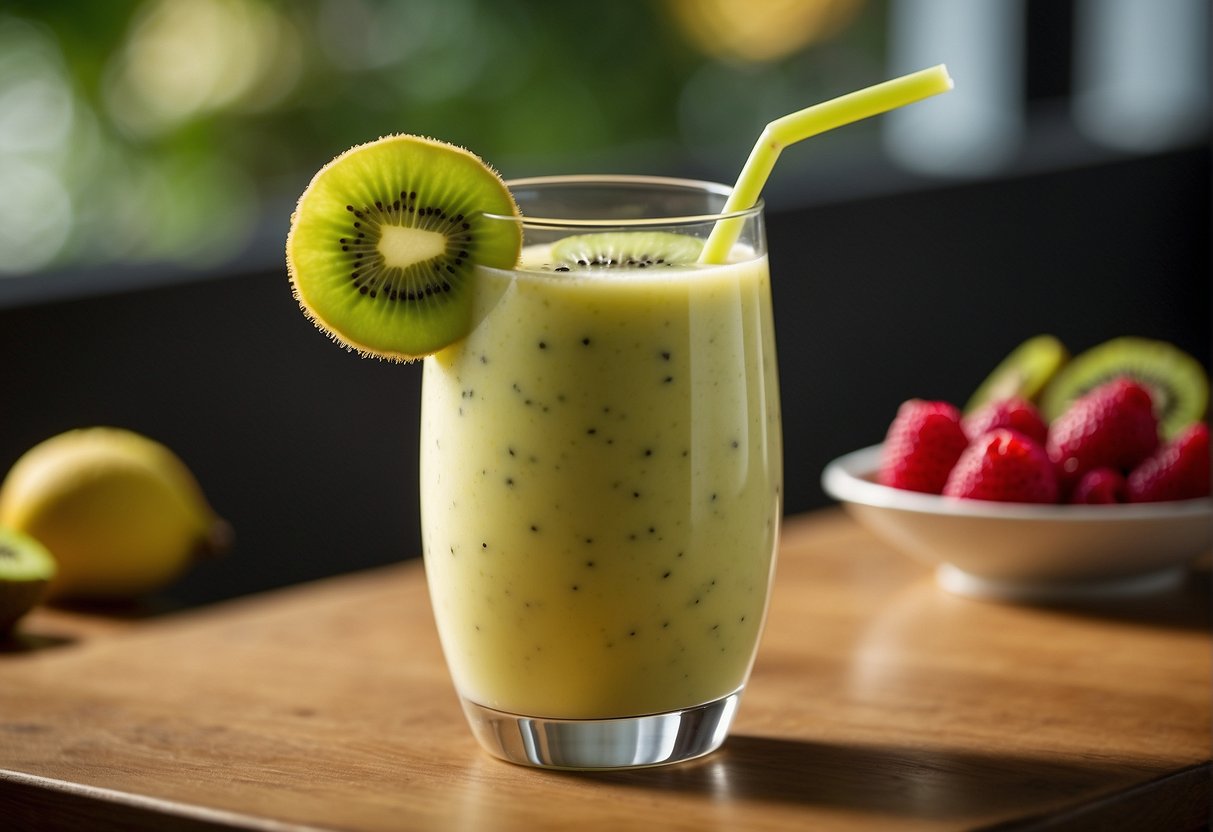
When I whip up a banana kiwi smoothie, I often skip the yogurt and opt instead for various dairy-free liquids that keep my drink vegan and refreshing. Here’s how I like to mix things up:
Using Various Nut Milks
I love the creaminess that nut milks add to my smoothies. Almond milk is a go-to for its subtle nuttiness that doesn’t overpower the other flavors. Sometimes, I’ll reach for cashew milk, which lends a creamy texture without adding too much of its own taste. Coconut milk is another favorite, especially when I want a tropical twist to my drink.
- Almond milk
- Cashew milk
- Coconut milk
Utilizing Water and Water Alternatives
Not in the mood for nut milks? No worries. Water is the simplest choice and it never fails to give me that pure, unadulterated fruit flavor profile. For a more dynamic twist, coconut water steps in to hydrate and inject a touch of sweetness and nuttiness. It’s fantastic for keeping things light and refreshing.
- Plain water
- Coconut water
Exploring Other Liquid Options
Still looking for more options? Oat milk and soy milk are great dairy-free alternatives. They’re mild in flavor, with oat milk being slightly sweeter and creamier. When I’m feeling adventurous, I’ll even incorporate fruit juice, like apple or pineapple, to add natural sweetness and make my smoothie even more fruity and delicious.
- Oat milk
- Soy milk
- Fruit juice (e.g., apple, pineapple)
Serving Suggestions
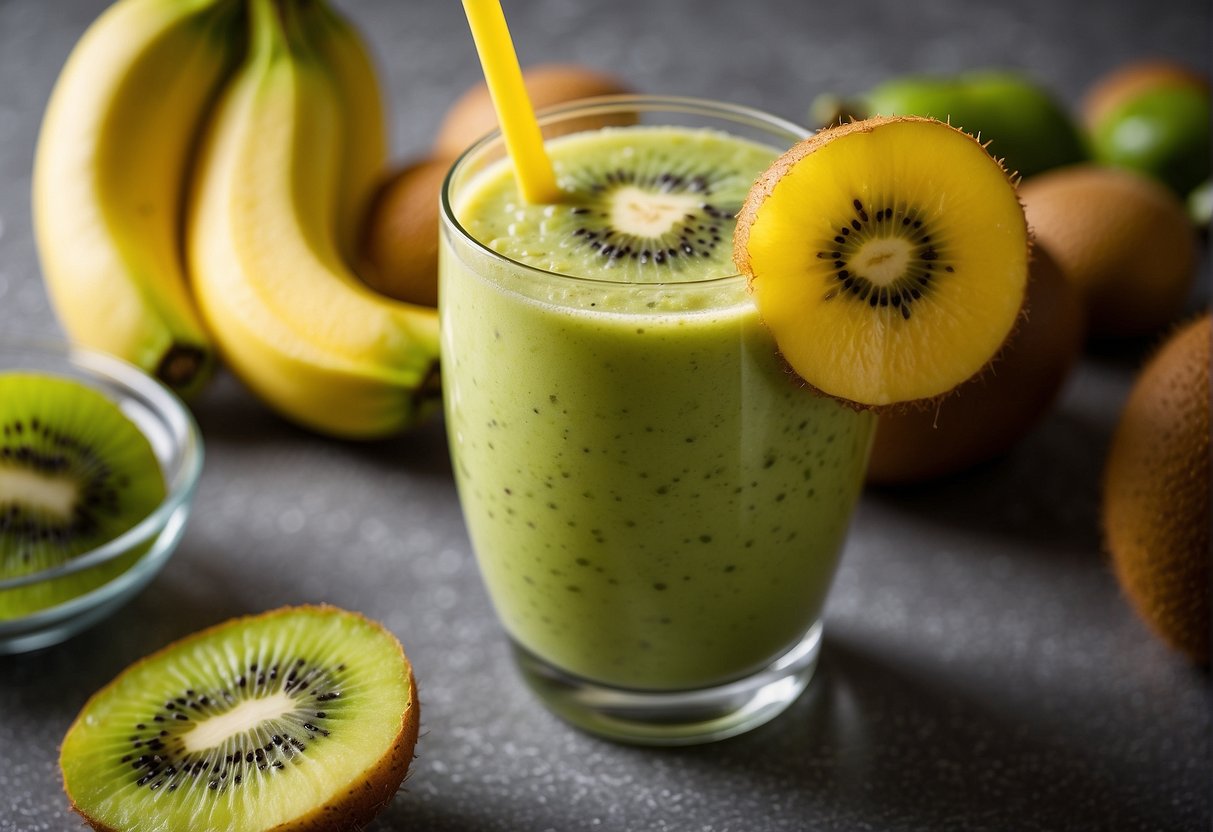
When I whip up a banana kiwi smoothie without yogurt, it’s not just about the blend, but also when and how I serve it. Let’s walk through some of my go-to tips.
Best Times for a Smoothie
I find this smoothie perfect as an easy breakfast, giving me an energetic start to the day, or as a mid-afternoon snack to ward off hunger until dinner. Its refreshing quality also makes it ideal after workout sessions to replenish my energy.
Portion and Serving Size
For me, a single serving usually consists of about 8-10 ounces. It’s enough to feel satiated without going overboard on calories. If I’m serving guests, I’ll just multiply that by the number of people to get my servings right.
Presentation and Toppings
I love turning my smoothie into a smoothie bowl by pouring it into a shallow dish and going wild with toppings. A sprinkle of oats, a handful of mixed nuts, some berries, and a drizzle of honey—each adds texture and extra flavor. A dash of cinnamon on top, and it’s ready to impress.
Popularity and Trends

In recent years, I’ve noticed a surge in the popularity of smoothies that focus on nutrition and dietary preferences, like those without yogurt. This shift coincides with an uptick in people looking for vegan and healthy smoothie recipes.
Social Media Buzz
I can’t scroll through my Instagram feed without seeing vibrant, colorful smoothie bowls and glasses, often featuring a banana kiwi smoothie. They’re not just eye candy, though. The high rating and positive comments beneath these posts show that people aren’t just making them for the ‘gram but genuinely enjoy the refreshing taste and health benefits. Hashtags like #HealthySmoothieRecipe are teeming with variations of banana and kiwi concoctions.
Smoothie Diet Culture
This banana kiwi combo taps into the smoothie diet trend that’s made waves recently. It’s an integral part of many healthy lifestyles, often as a meal substitute. From what I’ve gathered, its appeal lies in the simplicity of packing in nutrients without dairy or excess calories, fitting perfectly into a vegan or diet-conscious regimen.
Rise of Healthy Drink Options
The growing thirst for healthy drink options has certainly boosted the popularity of green smoothies. Places that once served primarily sugary drinks now have a healthy lifestyle section in the menu. Nutrition trends continue to favor drinks with fresh ingredients like banana and kiwi, making this dairy-free smoothie a go-to for a wholesome refreshment.
Post-Preparation Tips
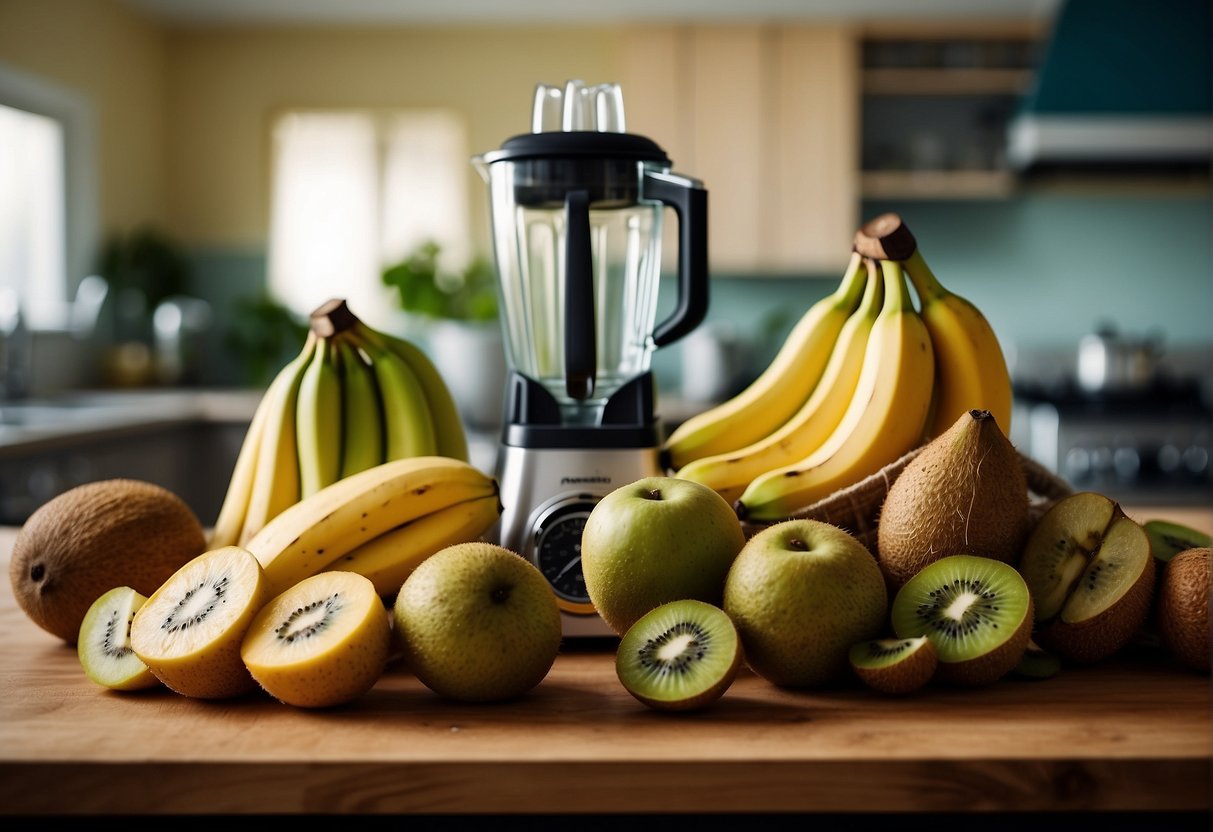
After whipping up my delicious banana kiwi smoothie without yogurt, I know that storing it properly and making it convenient to enjoy on the move can be just as important as the preparation itself. Keeping it fresh and handling cleanup swiftly will save me time and help keep things tidy in my kitchen.
Storage and Freshness
To ensure my smoothie stays fresh, I always aim to drink it immediately after blending, because that’s when the flavor and nutrients are at their peak. However, if I need to store it, I pop it in an airtight container and refrigerate it, which can keep it good for up to 24 hours. Beyond that, the smoothie might start to separate or lose its vibrant taste.
To-Go Tips
When I’m on-the-go, I pour my smoothie into a sealed travel mug or mason jar—these are lifesavers for transport and help prevent any spills. Always remember to give it a good shake before sipping, just in case there’s been any separation.
Cleanup and Blender Care
I’ve learned that immediate cleanup is the key to easy blender maintenance. Right after pouring my smoothie, I fill the blender halfway with warm water, add a drop of dish soap, and blend it for a minute. Then, I rinse it out and air-dry. This habit keeps my Vitamix or Ninja blender in top shape and ready for my next smoothie creation.
Supplementing with Smoothies
As smoothies are a powerful way to pack in extra nutrition, I often use mine as a meal replacement or to supplement my diet with essential vitamins. When I do, I make sure to include a good balance of fats, proteins, and carbs by throwing in ingredients like oats or a spoonful of nut butter. This ensures I’m not just getting a treat, but a nutritionally balanced mini-meal.
Customer Interaction
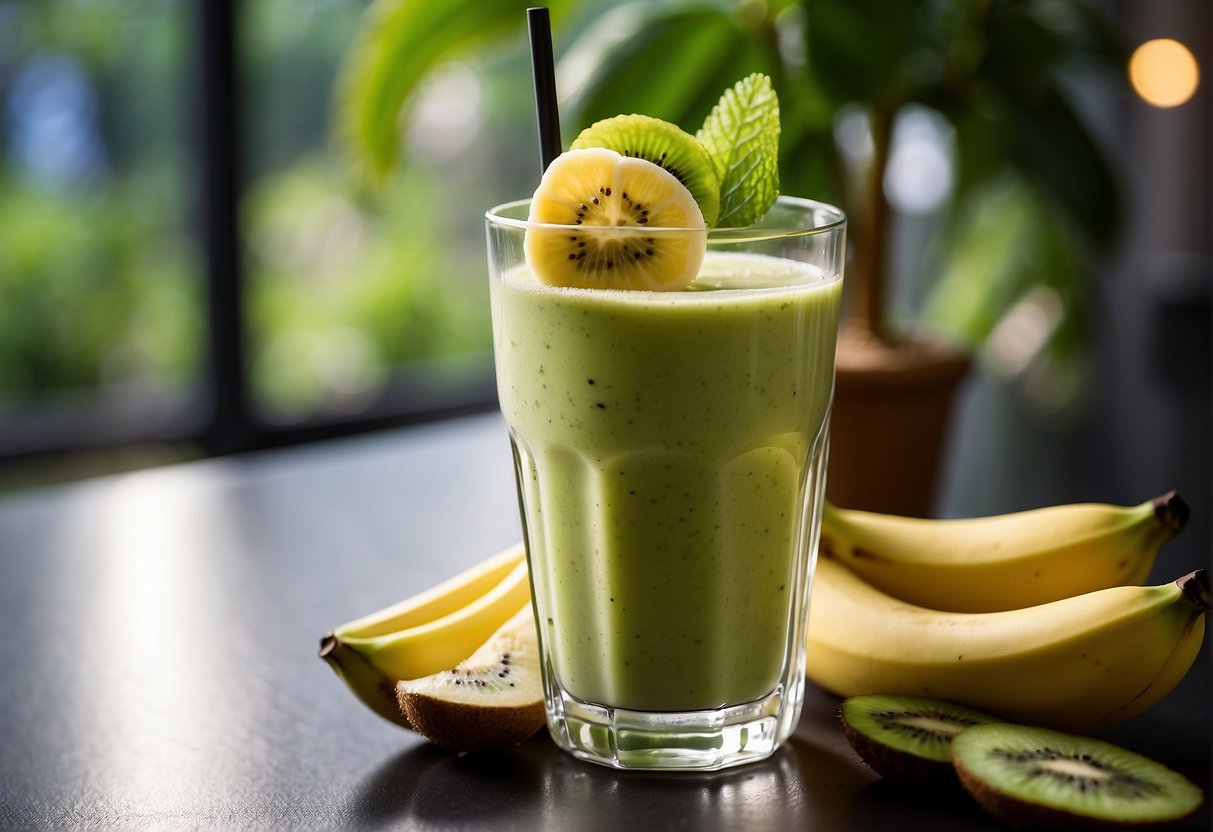
In the world of smoothie making, I find that engaging with customers is just as important as the recipe itself. People love sharing their experiences and as the creator, it’s awesome to see how each person makes the Banana Kiwi Smoothie their own. Here’s how I foster a fun and interactive community around this delightful dairy-free drink.
Encouraging Feedback
I always start by inviting customers to leave a comment or rating. This can be as simple as:
- “How did the Banana Kiwi Smoothie turn out for you? Rate it below!”
- “Drop your thoughts in the comments, I’d love to hear what you think!”
I keep an eye on the feedback and engage with it promptly to create a two-way conversation.
Photo Sharing
Seeing photos of how my smoothie turns out in your kitchen is a highlight of my day. I encourage you to share your masterpiece on Instagram or other social media platforms using:
- #BananaKiwiSmoothieChallenge
- “Tag me in your smoothie pics so I can share them!”
This not only shows off your skills but also helps spread the word about the recipe.
Recipe Sharing and Collaboration
My smoothie recipe is just a starting point. I’ve created a community space for sharing and collaboration where you can post adaptations of the recipe. Things like:
- Substitute ingredients
- Add-ins like chia seeds or protein powder
- Unique presentation ideas
This collective brainstorm leads to some amazing variations and fosters a sense of belonging.
Engagement Strategies
To keep our interaction fresh and exciting, I use various engagement strategies such as:
- Themed smoothie challenges with a prize for the most creative twist
- Q&A sessions about smoothie-making tips, live on Instagram
- Regular polls asking for your next smoothie flavor preferences
These activities build a vibrant and engaging online space, turning a simple smoothie recipe into an exciting part of your daily routine.
Frequently Asked Questions
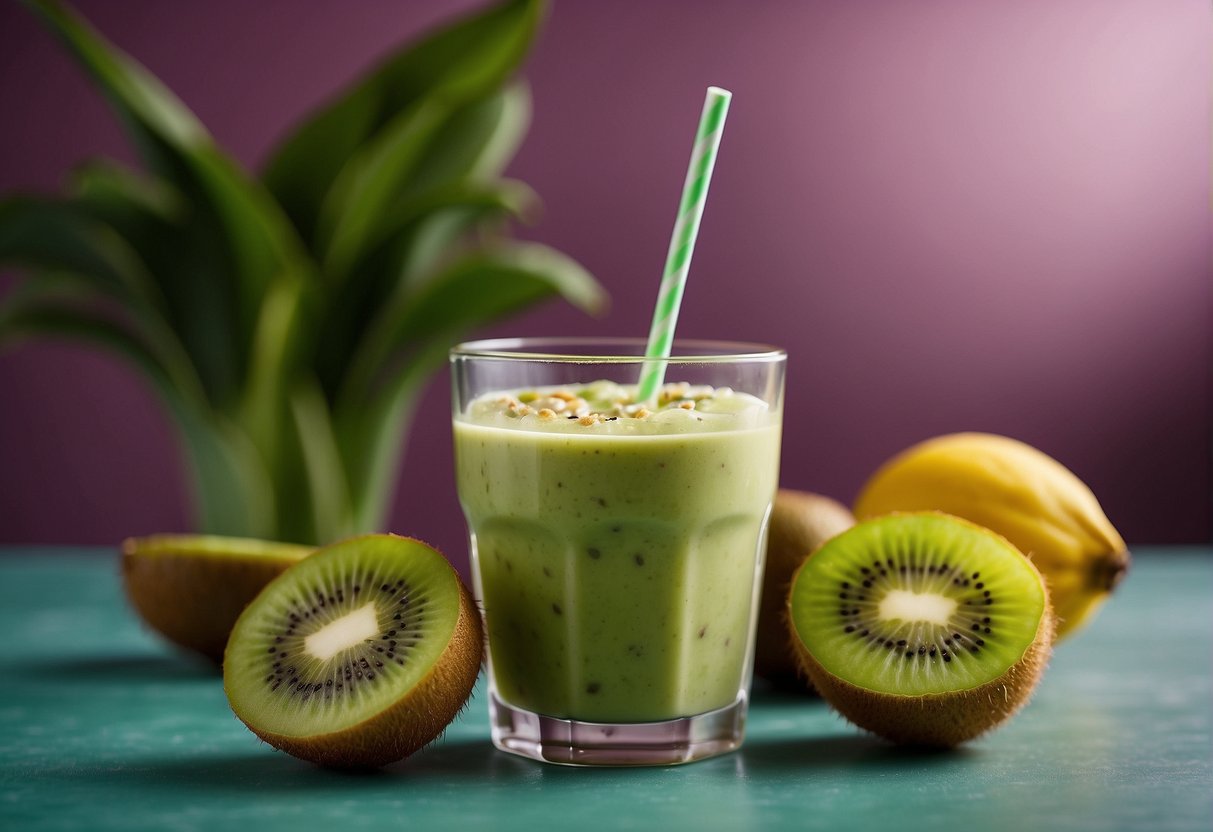
When I whip up a banana kiwi smoothie without yogurt, I keep it simple and healthy by using fresh ingredients and some clever swaps.
How can I make a healthy banana kiwi smoothie without using yogurt?
I often make a nutritious banana kiwi smoothie by blending ripe bananas and kiwis with a splash of milk alternatives like almond or coconut milk. I sometimes add a tablespoon of chia seeds for extra fiber and a scoop of vanilla protein powder to boost the protein content.
What’s the simplest way to prepare a banana kiwi smoothie if I don’t want to include yogurt?
For me, the simplest method is to toss bananas and kiwis into a blender, add your choice of liquid like juice or milk alternatives, and blend until smooth. It’s a quick and refreshing way to enjoy these fruits.
Are there any alternatives to yogurt that I can use in my banana kiwi smoothie?
Absolutely! I often use options like silken tofu, avocado, or soaked cashews to add creaminess without yogurt. These ingredients not only substitute the texture but also offer their own unique health benefits.
What are the benefits of drinking a banana and kiwi smoothie?
This kind of smoothie is a powerhouse of vitamins and minerals. Bananas provide energy-boosting carbohydrates and potassium, while kiwis are high in vitamin C and dietary fiber. Together, they create a drink that’s both nutritious and delicious.
Is it okay to combine kiwi with milk in a smoothie?
Yes, kiwi can be mixed with milk in a smoothie. Some people might have concerns about the enzyme actinidin in kiwi causing milk to curdle, but when blended and consumed promptly, it’s perfectly fine and makes for a creamy smoothie.
Can kiwi and banana be mixed together in a smoothie, and is it healthy?
Certainly! Kiwi and banana are a great combination for a smoothie. They offer a balance of sweetness and tartness along with nutrients like potassium and vitamin C, making it a healthy choice.
